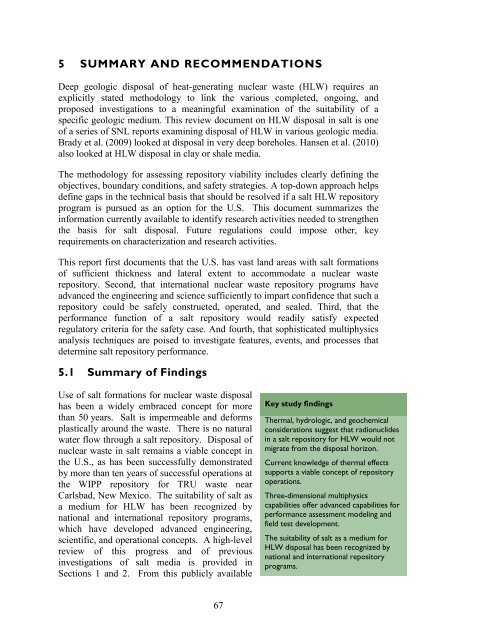Salt Disposal of Heat-Generating Nuclear Waste
Salt Disposal of Heat-Generating Nuclear Waste
Salt Disposal of Heat-Generating Nuclear Waste
You also want an ePaper? Increase the reach of your titles
YUMPU automatically turns print PDFs into web optimized ePapers that Google loves.
5 SUMMARY AND RECOMMENDATIONS<br />
Deep geologic disposal <strong>of</strong> heat-generating nuclear waste (HLW) requires an<br />
explicitly stated methodology to link the various completed, ongoing, and<br />
proposed investigations to a meaningful examination <strong>of</strong> the suitability <strong>of</strong> a<br />
specific geologic medium. This review document on HLW disposal in salt is one<br />
<strong>of</strong> a series <strong>of</strong> SNL reports examining disposal <strong>of</strong> HLW in various geologic media.<br />
Brady et al. (2009) looked at disposal in very deep boreholes. Hansen et al. (2010)<br />
also looked at HLW disposal in clay or shale media.<br />
The methodology for assessing repository viability includes clearly defining the<br />
objectives, boundary conditions, and safety strategies. A top-down approach helps<br />
define gaps in the technical basis that should be resolved if a salt HLW repository<br />
program is pursued as an option for the U.S. This document summarizes the<br />
information currently available to identify research activities needed to strengthen<br />
the basis for salt disposal. Future regulations could impose other, key<br />
requirements on characterization and research activities.<br />
This report first documents that the U.S. has vast land areas with salt formations<br />
<strong>of</strong> sufficient thickness and lateral extent to accommodate a nuclear waste<br />
repository. Second, that international nuclear waste repository programs have<br />
advanced the engineering and science sufficiently to impart confidence that such a<br />
repository could be safely constructed, operated, and sealed. Third, that the<br />
performance function <strong>of</strong> a salt repository would readily satisfy expected<br />
regulatory criteria for the safety case. And fourth, that sophisticated multiphysics<br />
analysis techniques are poised to investigate features, events, and processes that<br />
determine salt repository performance.<br />
5.1 Summary <strong>of</strong> Findings<br />
Use <strong>of</strong> salt formations for nuclear waste disposal<br />
has been a widely embraced concept for more<br />
than 50 years. <strong>Salt</strong> is impermeable and deforms<br />
plastically around the waste. There is no natural<br />
water flow through a salt repository. <strong>Disposal</strong> <strong>of</strong><br />
nuclear waste in salt remains a viable concept in<br />
the U.S., as has been successfully demonstrated<br />
by more than ten years <strong>of</strong> successful operations at<br />
the WIPP repository for TRU waste near<br />
Carlsbad, New Mexico. The suitability <strong>of</strong> salt as<br />
a medium for HLW has been recognized by<br />
national and international repository programs,<br />
which have developed advanced engineering,<br />
scientific, and operational concepts. A high-level<br />
review <strong>of</strong> this progress and <strong>of</strong> previous<br />
investigations <strong>of</strong> salt media is provided in<br />
Sections 1 and 2. From this publicly available<br />
Key study findings<br />
Thermal, hydrologic, and geochemical<br />
considerations suggest that radionuclides<br />
in a salt repository for HLW would not<br />
migrate from the disposal horizon.<br />
Current knowledge <strong>of</strong> thermal effects<br />
supports a viable concept <strong>of</strong> repository<br />
operations.<br />
Three-dimensional multiphysics<br />
capabilities <strong>of</strong>fer advanced capabilities for<br />
performance assessment modeling and<br />
field test development.<br />
The suitability <strong>of</strong> salt as a medium for<br />
HLW disposal has been recognized by<br />
national and international repository<br />
programs.<br />
67
















